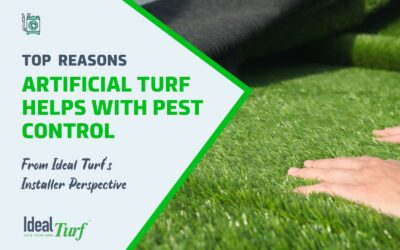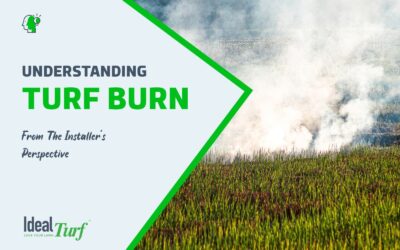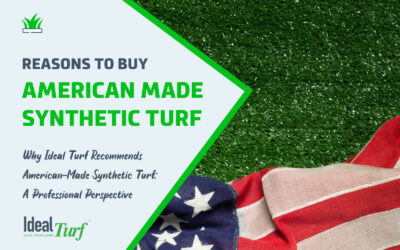A Head-To-Head Comparison Guide Of Fake Grass vs. Real Grass: Which One Should You Choose

Fake grass for residential lawns has been rising in popularity.
Artificial grass is a lot less needy in time and energy than a traditional lawn.
That doesn’t mean the choice of fake grass vs. real grass is always a clear-cut one.
There are advantages and disadvantages to both types of lawns.
And since fake grass is the proverbial new kid on the block, you doubtlessly have questions about artificial grass or whether an artificial lawn is all it’s cracked up to be.
- Will it look weird compared to the neighbor’s lawns?
- How much will it cost?
- Is there any maintenance involved?
- Will it withstand the tests of time, weather, dogs, and kids?
This article will give you a complete head-to-head comparison of the time, energy, cost, aesthetics, and maintenance involved in a natural grass lawn against an artificial one.
The information presented will give you what you need to make the best decision for your property.

Fake Grass vs. Real Grass
There are real pros and cons to artificial grass and natural grass lawns, and there are certain situations, climates, and locations that make artificial turf or natural grass the clear winner; other places may be suited for either and come down to your preferences on maintenance or aesthetics.
This guide will provide you with a detailed comparison of fake grass vs. real grass so that you can make an informed decision for your yard.
If you’re considering installing a putting green in your yard, you may find our comparison of artificial turf vs. real grass putting greens helpful.

Artificial Grass
The artificial grass of today has come a long way from the AstroTurf of yesteryear.
The technology and manufacturing process have improved, creating a product that looks, feels, and acts much closer to the real thing.
There are now a wide variety of artificial turf products available.
They vary in the type of material, pile height, color, and even the species of grass they seek to replicate.
Most synthetic turf is made primarily from one of three materials:
- Polypropylene
- Polyethylene
- Nylon
The different materials and their unique attributes customize artificial grass so it can be used in a wide range of residential and commercial applications, such as:
- Residential Lawns & Landscapes
- Commercial Buildings
- Dog Runs / Pet Areas
- Vets & Pet Care Facilities
- Backyard Putting Greens
- Hard-to-Mow Areas
- Playgrounds & Play Areas
- Rooftops, Decks, Patios & Balconies
- Swimming Pools Areas / Pool Decks
- …And More!
Looking to install artificial grass in other places around your home, check out our post about the 12 most common residential artificial turf applications.

Artificial Grass Benefits
The benefits of artificial grass are numerous for both homeowners, business owners and the environment.
Artificial turf maintenance is practically non-existent, which means less time spent mowing and less pollution from gas-powered lawn equipment.
Synthetic turf requires only the occasional spray down, rather than gallons and gallons of water each week.
This is great for water conservation as well as your water bill!

Natural Grass
Natural grass is definitely the most common lawn covering and has been for centuries.
It comes in dozens of varieties with differing blade widths, colors, growing conditions, and water requirements.
Unlike artificial grass, you need to be certain to choose the right natural grass cultivar for your climate.
Maintaining a healthy green natural grass lawn often requires a lot of time, patience, and persistence.
Natural grass needs regular:
- Mowing
- Edging
- Aerating
- Fertilizing
- Weeding
- Watering

Natural Grass Benefits
The environmental benefits are a chief selling point for natural grass.
Once your grass becomes established, however, it reseeds itself.
As long as you maintain the grass, it will come back year after year, never having to be replaced (unless there’s a bad drought or the weeds get completely out of hand).
As a plant, grass participates in producing oxygen for the atmosphere and taking up CO2 and other pollutants.
Its roots hold the soil in place, preventing erosion.
Grass is also an important part of the microscopic ecosystem beneath your feet, providing food and a home for various birds, insects, rodents, and other organisms.
Natural grass improves soil chemistry and cools the air as well.

Environmental Impact
While this might seem like natural grass would be the clear-cut winner, the reality might surprise you.
Read on to find out more about the environmental concerns and impacts of natural grass and fake grass.

Environmental Impact of Fake Grass
With water conservation concerns on the rise, fake grass makes more sense now than ever.
Homeowners are tired of watching their hard work of mowing, weeding, and fertilizing go to waste as summer water restrictions force them to let their once-perfect turf turn crispy and brown.
Artificial grass requires no water to stay green and pristine—only the occasional rinse every one or two weeks to remove dust, pet urine, and/or debris.
You can skip the cupboard-full of hazardous fertilizers, herbicides, and pesticides that natural lawns need when you have artificial grass.
For this reason alone, an increasing number of people are receptive to the idea of swapping their natural grass lawns for fake grass.
Synthetic grass doesn’t require conventional lawn care equipment either.
By eliminating lawn mowers, edgers, and weed whackers, you reduce pollution in the manufacture and operation of these tools.
You’ll also save considerable time, money, and garage space since you no longer need them!

Environmental Impact of Natural Grass
Just because grass is a natural plant doesn’t make keeping a grass lawn an environmentally friendly idea.
Statistics show that the average natural grass lawn owner will spend 70 hours a year on lawn maintenance.
The EPA also reports that a push mower emits as much pollution in one hour as 11 cars and a riding mower emits as much as 34 cars.
So even if only half the maintenance time is spent mowing, that’s akin to the pollution of a car running for 7.5 hours every week—just to cut the grass!
The EPA also states that grass clippings are the third largest component of municipal solid waste in landfills.
So unless you’re using a completely manual mower and composting your lawn clippings, your “natural” lawn is a substantial source of pollution.
The environmental impacts of what happens in your lawn are as much of a problem as what happens on your lawn.
Lawn fertilizers and pesticides are responsible for problems such as algal blooms, fish deaths, and pet and child cancer.
So while a traditional grass lawn may seem like the nature-friendly choice, the environmental costs to having one are sizable.

Aesthetics
Most people want a smooth, green, beautiful lawn to walk, play, and relax on.
Let’s take a look at the aesthetics of fake grass vs. natural grass and the work it takes to achieve a lovely lawn of each type.

Fake Grass Aesthetics
Artificial grass is available in a variety of colors, lengths, densities, etc., which means homeowners can have a synthetic grass lawn that always looks perfect and matches their neighbors’ lawns.
Synthetic grass has come a long way since the stiff, plastic AstroTurf of the 60’s.
Artificial grass now looks and feels exactly like the real thing.
It also eliminates dead patches and bare spots from shade or pet urine, and it improves curb appeal.

Natural Grass Aesthetics
A traditional grass lawn definitely gives a more beautiful, natural look to your outdoor space, but without a lot of weekend hours or a full-time gardener, keeping a natural grass lawn even, green, and weed-free can be a major challenge.
It’s pretty much impossible to have an aesthetically pleasing natural grass lawn without massive expenditure of both time and/or money—especially in Texas, where the summer heat dries everything out.

Safety & Cleanliness
Even if you don’t mind that the lawn isn’t picture-perfect, having a safe, clean lawn is a top priority if you have children or pets.
Below we’ll provide an overview of the safety and cleanliness of fake grass vs. real grass.

Fake Grass Safety & Cleanliness
There are a number of common misconceptions surrounding the safety of artificial turf.
For instance, many people erroneously believe that the crumb rubber infill, made from recycled tires that is used in a variety of artificial grass applications is harmful to children.
This is not true—unless copious amounts are ingested.
Also, crumb rubber infill is not used in residential turf installations.
We use rounded silica sand infill in our installations to help maintain the turf’s structure, resilience, and natural feel.
The truth is that synthetic turf keeps kids and pets both clean and safe.
The advantages are numerous, as fake grass:
- Provides a smooth, even surface for playing, which prevents injuries from falls
- Keeps mud and dirt to a minimum, which means clean kids and pets
- Allows water and pet urine to flow right through the DUAL FLOW backing turf drainage system
- Antimicrobial additives introduced during the manufacturing process (like our “Microbe-Safe” backing) prevents the build-up of bacteria and odors
This combination of features results in cleaner, safer children and furry friends.

Real Grass Safety & Cleanliness
While kids love the feel of fresh grass under their feet, natural grass has the potential to compromise the safety of children and pets.
Dead spots and clumps of grass can be tripping hazards for running kids.
The chemicals and fertilizers used to keep lawns looking nice all pose dangers to unsuspecting toddlers, cats, or dogs that might ingest them by accident.
Grass lawns also tend to attract puddles and mud when it rains and dirt and dust when it’s dry, all of which spell more laundry and mud prints to clean when the kids and dogs come inside.
Natural grass also leaves stains on children’s clothes.

Installation Costs
The installation costs vary greatly between synthetic and natural grass.
In order to give you an apples-to-apples comparison of a fake grass installation vs. a real grass one, we’ll use a 1,000 sq. ft. yard as an example.

Fake Grass Installation Costs
Unlike a natural grass lawn, the main cost to a synthetic grass lawn is upfront.
Artificial grass costs between $6.00 – $20.00 per sq. ft. for installation and materials.
The high initial cost of artificial grass should be thought of as an investment because it pays for itself over time.
The break-even point between a fake grass installation and a natural grass one is usually between 4 and 6 years.
The installation costs of an artificial grass lawn is influenced by a number of factors:
- Materials
- Operation Fees
- Labor
- Company Overhead
- Type of Artificial Grass
- Site Prep Required
For a quality artificial grass installation, the price per square foot will start around $8 – $10.
That means for a 1,000 square foot area, the installation cost would start around $8,000 – $10,000.
If you’d like help deciding which turf product is right for you, check out our complete buyer’s guide on how to choose the best artificial grass.


Natural Grass Installation Costs
To grow a natural grass lawn, you can install sod or plant seeds.
Both have advantages and disadvantages.
For this example, we’ll assume the lawn needs the installation of an irrigation or sprinkler system.
Sod
For the same 1,000 square-foot lawn, it will cost between $900 and $1,800 to install sod.
The sprinkler system will cost between $0.46 and $0.79 per square foot.
New sod will need a good inch of water on the day it’s planted, as well as daily ¼-inch waterings for at least two weeks, or until it is well-rooted.
This works out to be around 2,804 gallons of water for a 1,000-square-foot yard, or $10.50.
If you assume middle-of-the-road pricing, the installation costs will look something like this:
$1,350 for sod + $600 for sprinkler system +$10.50 for water = $1,960.50 total
This is a very general estimate; the total cost will vary greatly based on the type of sod you use, how hot it is when you install, whether or not you prep the site and install the sod yourself, how advanced your sprinkler system is, the grade of your lawn, etc.

Seed
Lawn seed costs between $0.09 and $0.18 per square foot.
The lawn will also need the same $660 irrigation system.
Planting seeds to grow a natural grass lawn will require intense watering for the first eight weeks.
623 gallons of water or rain is equivalent to one inch of water for a 1,000 square foot area.
The total amount of water needed for grass seed germination is about 40 inches of water or 24,920 gallons.
This accounts for the 8 inches of moist soil needed before planting, 4 inches of moist soil immediately after planting, and 2 inches of moist soil twice a day until the seeds sprout.
One inch of water soaks about 6 inches of soil.
Factoring in the cost of water for a single-family customer in Texas, the cost of water based on the usage above will equal about $197 dollars (base fee of $5.38).
The total price breakdown of installing a seed lawn is as follows:
$135 for seed + $660 for sprinkler system + $197 for water = $992 total
This only includes water to get the seeds to germination.
You’ll need to keep your lawn moist for the remainder of the season while the grass establishes, which will be an ongoing expense.
![Care & Maintenance Costs [25 Year Lifespan of Turf]](https://ideal-turf.com/wp-content/uploads/2021/06/Care-Maintenance-Costs-25-Year-Lifespan-of-Turf.jpg)
Care & Maintenance Costs [25 Year Lifespan of Turf]
Once your lawn is in, you still have to pay to care for it and maintain its beauty.
Check out our overview below on the care and maintenance costs of fake grass vs. real grass, using the 25-year lifespan of turf as the timeframe.

Fake Grass Care & Maintenance Costs
Artificial grass is nearly maintenance-free compared to natural grass.
This is where you’ll see the return on your initial investment in artificial grass.
Here’s a brief schedule of the care and maintenance requirements of fake grass, as well as the associated costs.
- Spraying w/ hose: $6 a month (0.25 inches bi-weekly)
- Power brushing: $175 (annually)
- Infill replenishing: $100 minimum (annually)
The total of maintaining your synthetic lawn is around $281 annually or $7,025 over 25 years.

Natural Grass Care & Maintenance Costs
While the installation of natural grass is much cheaper than fake grass, the requirements of a natural grass lawn are high and continual.
Most lawns require weekly cutting for at least 6 months out of the year, with a few extra, intermittent chores like leaf blowing, edging, and weeding.
Lawn care prices range from $25 to $50 per visit for mowing and edging.
Assuming a price of $30 per visit, mowing and edging alone will cost $780.
Below is a list of what you can expect to spend on your natural lawn each year.
Again, we’re assuming a small, 1,000-square-foot lawn, so these numbers are on the low end of the spectrum.
- Mowing/edging – $780 annually ($30 per week for 6 months)
- Spring/fall cleanup – $100
- Fertilizing – $80
- Aeration – $70
- Weed abatement – $35
- Sprinkler repair – $180
- Leaf cleanup – $190
- Watering – $567 (623 gallons per week for 1,000 square feet for 6 months)
All this adds up to $2,002 per year.
Over 25 years, you’ll spend a whopping $50,050 maintaining your natural grass lawn!

If you elect to mow, edge, and weed the lawn yourself, you may pay slightly less than the amount projected here, but you’ll also have the costs of purchasing, storing, fueling, maintaining, and repairing equipment such as a lawn mower, edger, weed eater, spreader, etc.

Fake Grass vs. Real Grass: Which Should You Choose for Your Lawn?
If you’re bent on the cool, springy feeling of grass between your toes, nothing will beat natural grass.
But you’ll pay a hefty price in water, money, and maintenance to get it.
If, however, you’re open to the idea of free weekends, more cash in your pocket, and a set-it-and-forget-it landscaping option, artificial grass is the lawn for you.
It’s also a great choice if you’re in a drought-prone area of Texas, since synthetic turf stays beautiful and green year-round.
If you’re interested in an artificial grass installation in Texas, please contact Ideal Turf today to get your FREE Artificial Grass Design & Installation Estimate by clicking “GET A QUOTE” button, or feel free to give us a call at 800-204-4650.
Author: Tim Taylor
Recent Posts
- How Synthetic Turf Helps Keep Fleas and Ticks Out of Your Texas and Oklahoma Yard
- Porches, Patios & Personality: Creating Outdoor Spaces Texans Love
- Turn Your Backyard into a Golfer’s Dream: Custom Putting Greens by Ideal Turf
- Why Texas Pet Owners Are Choosing Pet-Friendly Artificial Grass from Ideal Turf
- Why More Texans and Oklahomans Are Turning to Artificial Grass for a Greener Future






